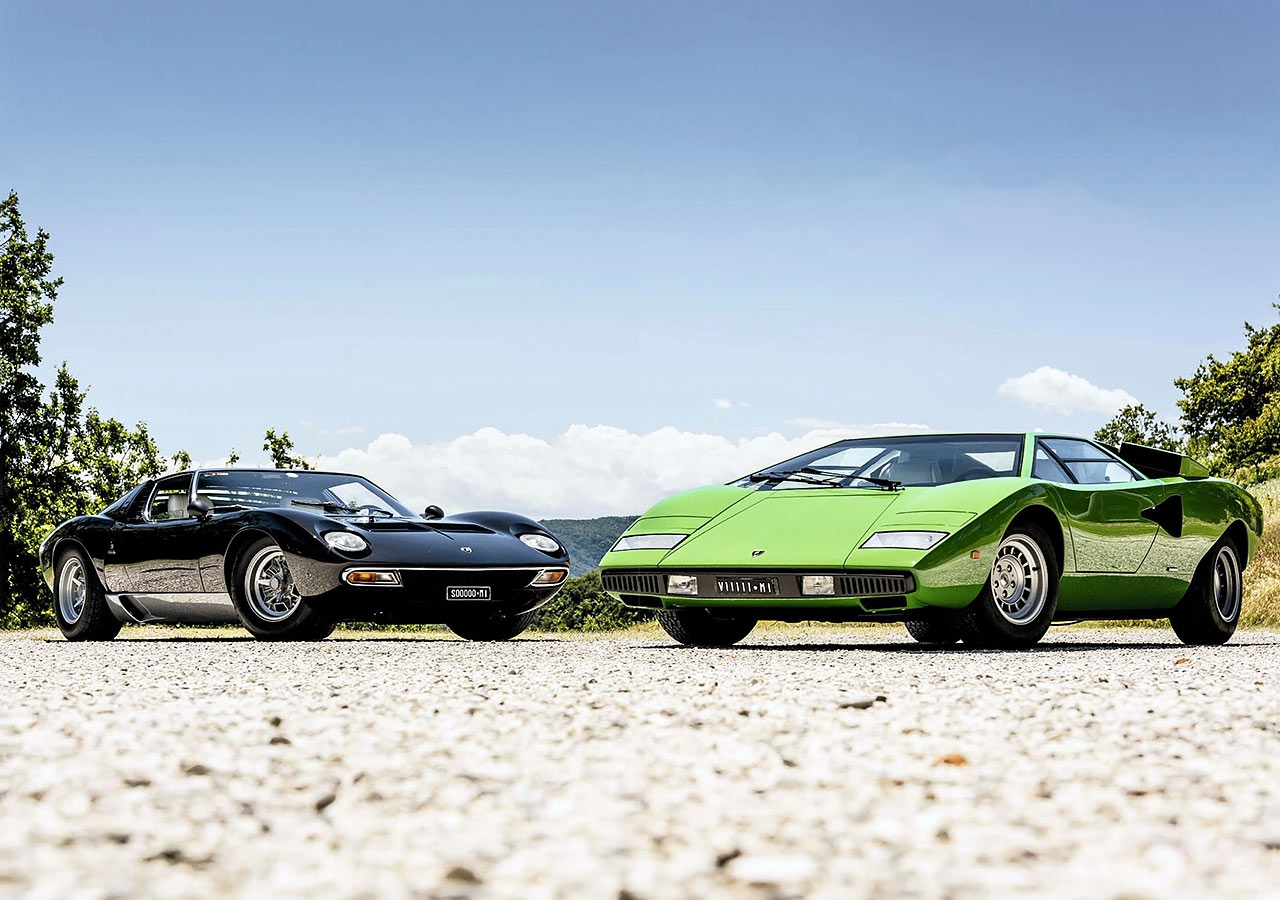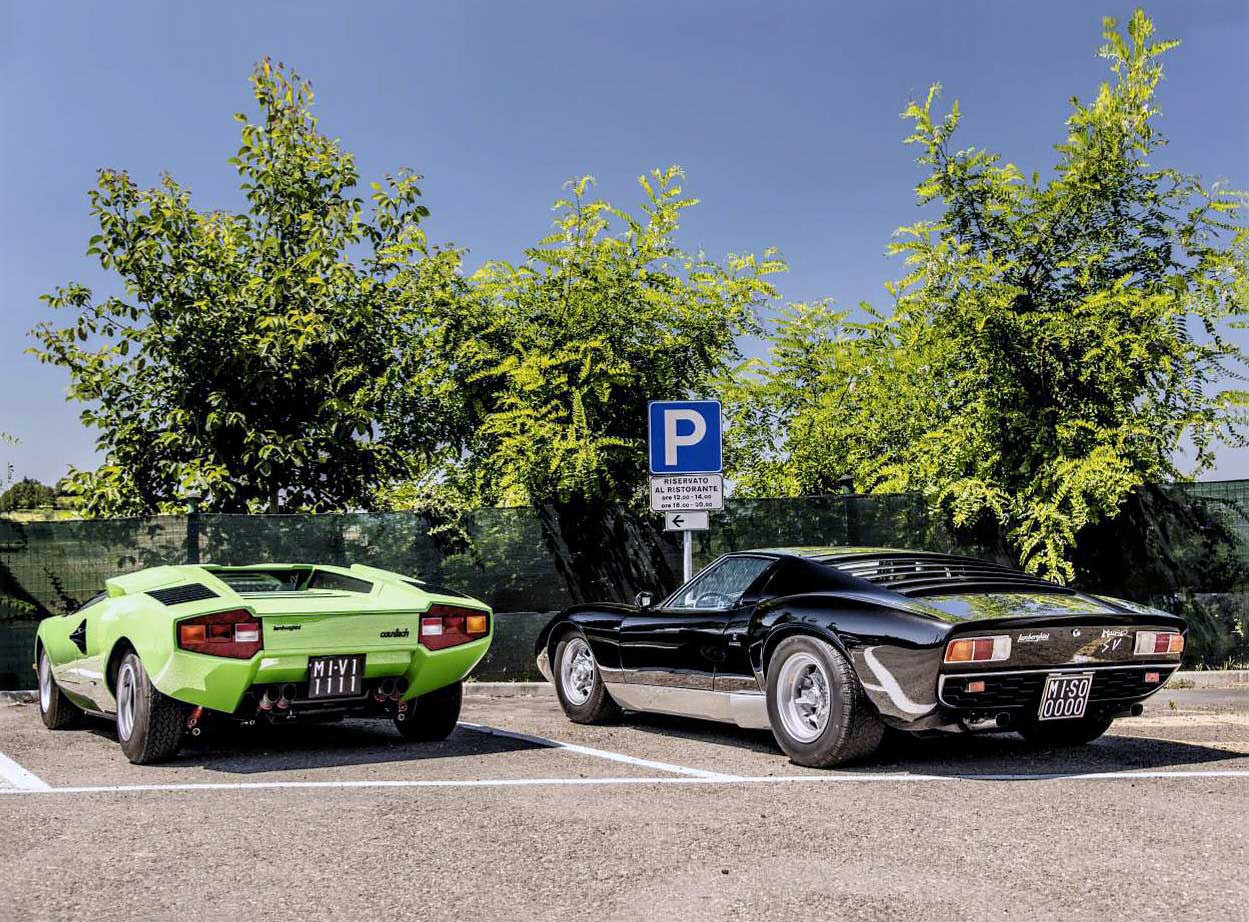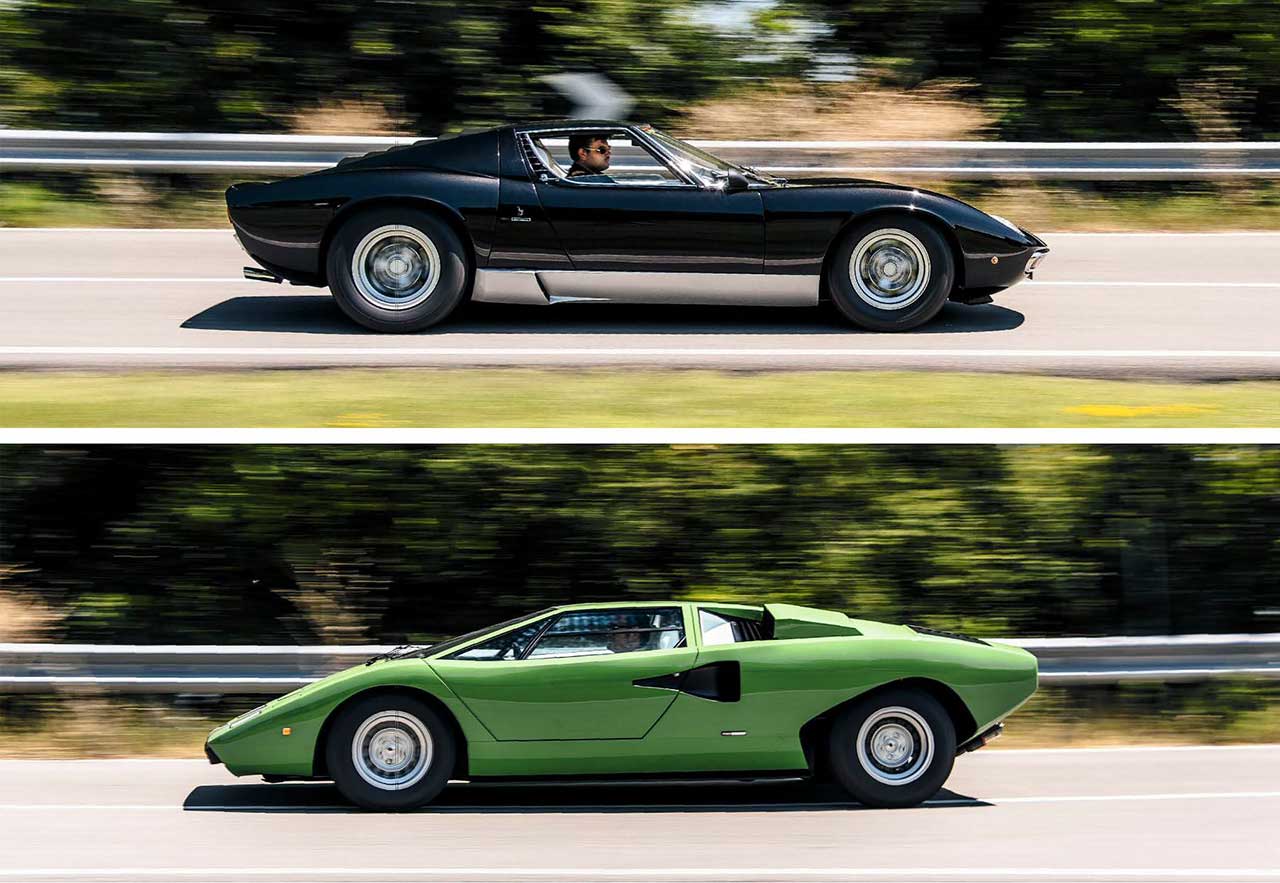
Miura SV vs. Countach LP400. We pit the last of the Miuras against the first of the Countachs… with a little help from former Lamborghini test-driver, Valentino Balboni. Italian industrialist heir Gianfranco Innocenti bought himself the last Miura SV Lamborghini made, then replaced it with one of the first Countachs. We drive them in their Modenese homeland. Words Sam Dawson. Photography Jonathan Jacob.

Early Countach meets late Miura in Lamborghini’s heartland. We drive the ex-Innocenti Lamborghini Miura and Countach. The Countach may have replaced the Miura but early LP400 is much trickier to drive hard.
You’re looking at two of the greatest shocks to the motoring world’s system, in their natural habitat. Not in a museum or as a static exhibit at a concours event – not even in a cloud of dry ice on a motor show turntable. But rather emerging like alien landing craft from dusty, parched workshops on the outskirts of Modena and exploring the surrounding landscape at speeds that leave onlookers bewildered, wondering what they’ve just seen.
These Lamborghinis ordered new by industrial heir Gianfranco Innocenti in the Seventies weren’t the user-friendly massmarket supercars of today, churned out of factories in their thousands and backed up by comprehensive three-year warranties. His Miura SV was the last of just 150, its aggressive Spinto Veloce – literally ‘pushed faster’ – spec so secretive that the sole contemporary magazine road-test – Doug Blain writing for CAR – took place 18 months after Lamborghini had stopped making it. Innocenti’s Countach was the earliest he could get his hands on, one of a magnesium-sprinkled pilot batch of between 10 and 20. It’s officially chassis number five but several of its parts bear serial number one.

Purists love the LP400’s uncluttered lines, but later models’ big wings provide much-needed downforce in the corners.
It would be disingenuous to judge Innocenti a typical playboy with a throwaway attitude – to buy the very last Miura at its most blood-spitting intensity, then replace it months later with the most radical sporting car the world had yet seen in its most prototypic state took genuine bravery. Looking at this pair of cars in such a timeless landscape lends them the effect of modern art, with all that brings. Challenging. Question-generating. And as incongruous as a pickled shark in the National Portrait Gallery. Innocenti was clearly a connoisseur.
I should be overjoyed – I’m about to drive Lamborghini’s purest cars on some of Italy’s most spectacular roads on a hot summer day with former development driver Valentino Balboni in tow. But I feel as though my vertebrae have been replaced with ice cubes. Again, like the finest works of art these cars carry seven-figure price tags, but you don’t fill a Picasso or a Duchamp with flammable liquid and fling it around the countryside.
Early impressions of the Miura suggest it’s going to be a friendlier companion than the Countach. Although mid-engined it clearly has more conventional stylistic roots with its long nose and lack of overt side-ducting making it seem more familiar. There’s plenty of headroom inside – even for me at over 6ft – and the laid-back driving position and swelling front wings stretching out ahead put me in mind of a Jaguar E-type coupé.
There isn’t much legroom though, forcing a splayed position around the low wheel, but at least the dashboard is minimalist enough to accommodate both knees and twirling knuckles. The instruments ahead are limited to speedometer and rev-counter hanging off a leather shelf, with auxiliary gauges in a central binnacle angled towards me. A glance in the rear-view mirror reveals that the angled louvres over the engine are a genuinely functional visibility aid. The rear screen sits vertically behind my head, the louvres there to maintain the aerodynamic sweep of the bodywork while venting heat out of the engine bay – a feature first seen on Le Mans Ferraris, later squandered on Mustangs and Capris.
‘The V12’s harsh bark is replaced by an aggressive induction crackle’
The V12 may be fed by four carburettors but it fires as abruptly as a fuel-injected engine, its initial harsh bark replaced by an aggressive induction crackle underlaid by a smooth, deep hum – a reminder of the inherent balance of a V12 engine.
Unfortunately, although the visibility is excellent for a mid-engined supercar, it’s not exactly user-friendly. The floor-hinged pedals are extremely stiffly-sprung and jut out at such an angle that the longerlegged – ie. me – have to bend their feet back, painfully straining Achilles’ tendons to avoid riding them. As a result it’s difficult to pull away smoothly in first gear without getting a slight whiff of clutch. It’s surprisingly quiet once up to speed, though. Not subdued – certainly not from the outside – but the combination of the glass partition and rear louvres serves to channel most of the engine’s noise away from my ears. As a result the main sound that fills the cockpit is gearbox whine, and I plan and fine-tune my gearchanges by listening to the coruscating cogs, changing up or backing off the throttle when they begin to scream.

The Miura was at the height of its power in 1973 but the Countach had yet to realise its full potential.
The engine is remarkably tractable and much easier to control once I’ve slipped the gearbox into second. It’ll sit on low-down torque in second comfortably at 1800rpm but a prod of the throttle sees it fly beyond 4000rpm in an instant. I’ve passed 70mph by the time I slam it into third and then I really do hear the engine – a frenzied, cammy thrash followed by an artillery barrage of overrun pops. Yet despite the aural drama, there’s no sudden wallop of torque – its seamless delivery is more akin to a Jaguar E-type V12.
However, all E-type comparisons disappear in the bends of the northern Italian Apennines. The stiff chassis frame and relatively long – by mid-engined standards – wheelbase lend the Miura a planted, instantly compliant feel. There’s a nose-darting responsiveness akin to a well-balanced front-engined, rear-drive GT like a Porsche 968 or Lotus Excel, with all the mid-corner throttle-adjustability that brings.
The steering is wonderfully wieldy, unencumbered by the weight of an engine, its two-and-a-half turns lock-to-lock encouraging a steering style where I feed the wheelrim through my fingertips and enjoy its milimetric nuances. It’s a technique the car forces upon the driver rather than one that I’ve affected, but I realise I’ve seen it before, in the manner of the mysterious Beckermann in the opening title scene of The Italian Job.
The Miura SV may not be as serious a machine as some latterday supercars but it’s more friendly as a result despite its brutal gearchange and violent clutch.
By contrast, the Countach comes with a health warning from Balboni. ‘You always have to concentrate hard in an LP400,’ he says. ‘The Miura is beautifully balanced and easier to set up but the Countach is rear-engined – the gearbox is in front of the engine. The weight is biased towards the back and because we didn’t have the bespoke Pirelli tyres before we released it, the sidewalls are too high, raising the centre of gravity and increasing cornering roll. It wants to oversteer even in a straight line.’

Countach’s dramatic cab-forward stance suggests it’s mid-engined, but it’s actually rear-engined.
That said, even though the Countach is near-impossible to reverse accurately unless you sit on the sill with the door open, it doesn’t seem as intimidating as Balboni suggests. The Miura’s pedals forced me into a stress-position and its lens-shaped windscreen concentrated searing sunlight into my face but the Countach is a futuristic cocoon contoured to my body, my legs comfortably stretched out, the roof shielding me from the sun’s glare and like the Miura, the white leather adds much-needed airiness to the cabin.
The Countach is a stark modernist future-shock after the chromeedged, conventionally beautiful Miura, its every detail a result of Marcello Gandini’s clean slate thinking, its very presence visually jarring within whatever landscape it inhabits. And yet there’s no particular flamboyance about it – no wild wings or skirts. The simple black plastic boot badges are unassuming, and a Hillman Hunter finished in this deep shade of green would slip by unnoticed. If the Miura is Bob Dylan shocking the Free Trade Hall with an electric guitar solo, then the Countach is an abrupt blast of Kraftwerk.
The 4.0-litre V12 is much more vocal and intrusive when positioned Longitudinale Posteriore in the Countach, its deep pulsating baritone filling the cabin. There’s more room than I was expecting but it’s hard to get comfortable in the constant-radius curve of the seats because there seems to be no point where my backside naturally rests. However, this is countered by a clutch, accelerator and gearbox that are much slicker and more progressive than the Miura’s, making it easier to slink out of junctions – just as well given the way rear three-quarter visibility is obliterated by the radiators’ air scoops. The periscopic roof is a charming gimmick but serves only to put a metal bar across the view through the mirror.
This sense of slickness makes it absurdly easy to get the Countach up to silly speeds, bellowing all the way, the exhaust note rising in stabs of accumulating intensity. It’s difficult to read the tiny instruments but 60mph is already a distant memory when I finally dare to glance down at them while indulging in any gear higher than second. There’s a tractable supply of torque though, so I can pick and comfortably sustain any cruising speed between 30mph and 130mph without the engine or gearbox sounding strained.
Unfortunately it’s the very same factors that make the LP400 so aesthetically pure – the flat planar sides, narrow Cromadora wheels and abrupt, wingless rear deck – that detract from the driving experience. Turning into a high-speed corner soon has me wishing for more downforce. The combination of high-profile sidewalls, smaller contact patches than Bob Wallace wanted and that highmounted V12 means that the car lurches and wanders alarmingly.
The tough, physical steering needs only minimal nudges and the car pivots urgently around the driver, but with a disconcerting sense of uncontrolled vagueness that demonstrates why the 1978 LP400S’s wing and splitter couldn’t have arrived soon enough. However in the LP400 it’s clear that we have the origins of a much better car than the Miura, even if the more polished – if also more challenging to drive – SV in its definitive form has the edge.
Purists won’t want to hear this, but the lairier-looking late Seventies Countach S was the product of thorough development that was frankly unheard of in the early days of mid-engined Lamborghinis. So maybe Innocenti was right to move on from them so quickly, to spur Sant’Agata towards better things. After all, without the pioneering spirit of customers like him, its engineers may never have taken that crucial first step at all.
Thanks to: Simon Kidston, Emanuale Collo & Luca Salvioli, Orazio Salvioli and Valentino Balboni
TECHNICAL DATA 1973 Lamborghini Miura P400 SV
Engine 3929cc V12, dohc per bank, four Weber 40 IDL3L carburettors
Power and torque 385bhp @ 7700rpm; 286lb ft @ 5500rpm
Transmission Five-speed manual, rear-wheel drive
Steering Rack and pinion Suspension Independent, double wishbones, coil springs, telescopic dampers and anti-roll bar front and rear
Brakes Servo-assisted discs front and rear
Weight 1298kg
Performance Top speed: 180mph; 0-60mph: 6sec (never independently confirmed)
Fuel consumption 13mpg
Cost new £8983
Values now £1.8m-£2.4m
{module Lamborghini Miura}
TECHNICAL DATA 1974 Lamborghini Countach LP400 Periscopa
Engine 3929cc V12, dohc per bank, six Weber 45 DCOE carburettors
Power and torque 375bhp @ 8000rpm; 268lb ft @ 5000rpm
Transmission Five-speed manual, rear-wheel drive
Steering Rack and pinion Suspension Independent, wishbones, coil springs, telescopic dampers and anti-roll bar front and rear
Brakes Servo-assisted discs front and rear
Weight 1084kg
Performance Top speed: 180mph; 0-60mph: 5.6sec
Fuel consumption 15mpg
Cost new £18,000
Values now £1m-£1.5m
{module Lamborghini Countach}
ORAZIO SALVIOLI ‘I TESTED THEM’
Orazio Salvioli was in charge of Lamborghini’s team of test-drivers between 1967 and 1975 and carried out the pre-delivery inspection on the Countach.
‘We would take cars of the production line, checking for defects against a list,’ he explains. ‘Bob Wallace would take them for a drive and tell me what was wrong so we could ix it before the car went to the customer.

‘Countach production looked a bit like a restoration workshop’. Excellent visibility, but stiff-floor-mounted pedals are a pain for longer-legged drivers. Quad-cam V12 delivers seamless torque from as little as 1800rpm. Miura’s cabin is dominated by screaming gearbox whine at speed.
‘Any problems were usually stupid little things like door locks not working, but one issue with all the Countachs seemed to be carburetion – the engines would be fine when bench-tested, but always needed recalibrating within 50-100 kilometres of road-testing.
‘Working at Lamborghini was like being part of a family back then. There were only two buildings on the site at the time and Ferruccio would pass by every morning and say hello to the workers.
‘The pace was laid-back and relaxed unless production deadlines were looming, then things would get more hurried, but there was no stress really. ‘But it worked. People didn’t realise how many cars we were making – at one point we were turning out 50 Urracos a month. We always had a conventional production line for the four-seater GTs, but Miura and Countach production looked more like a restoration workshop, with the cars pushed around on trollies. Wheelitting was the final stage.’
‘Countach production looked a bit like a restoration workshop’
GIANFRANCO INNOCENTI ‘I BOUGHT THEM’
‘My father bought me my first car – a De Tomaso Pantera – when I was 18,’ says Gianfranco Innocenti, coachbuilding heir and original owner of both Lamborghinis. ‘However, I also had a 750cc Kawasaki motorbike and my father said I could have any car I wanted if I got rid of it. Two days later we were in Ferruccio Lamborghini’s office ordering the Miura.

LP400’s gearbox and pedals are easier to operate than Miura’s, but visibility is poor. LP400’s rear-mounted V12 delivers less power and torque than Miura but has less weight to haul around. Former test-driver Balboni has big respect for the LP400, ‘It wants to oversteer even in a straight line’. Trademark ‘bull horn’ doors punctuate Miura’s traditional long bonnet, short rear deck profile.
‘Lamborghini and my father knew each other as fellow automobile industrialists so I was treated well. I wanted special features that I’d seen on the Jota – the rivets and racy bonnet and a more powerful engine. Lamborghini agreed, and added, “As a present I’ll have the inlet manifolds polished for you.” ‘I drove it non-stop around Milan at night but also down to Rome and back and even to St Tropez. I managed 180mph on the Bologna-Padova autostrada but had to add a litre of oil afterwards!
‘I did 13,050 miles in the year I owned it – it was reliable, though I had to have the second gear synchromesh replaced a few times. ‘The Countach was hot news and I was promised one of the first. I remember the day it arrived in July 1974, although I’d given supplying dealer Achilli Motors my Miura the previous December in partexchange.
The acceleration was amazing but it wasn’t quite as fast as the Miura. I think my father was relieved when I replaced it with a Rolls-Royce Corniche coupé two years later!’
{CONTENTPOLL [“id”: 87]}





